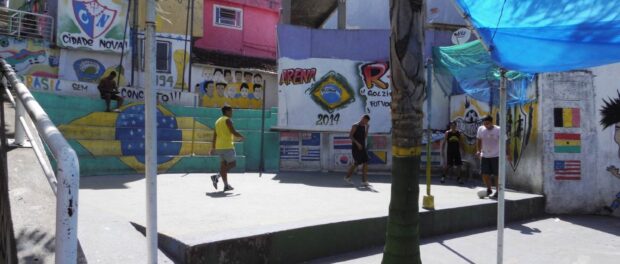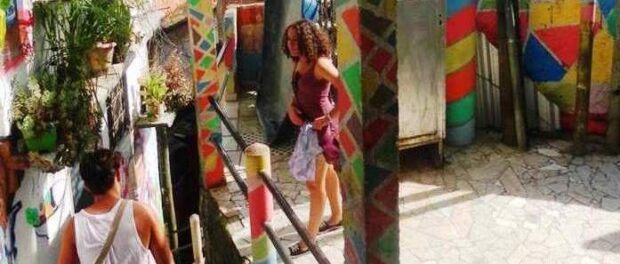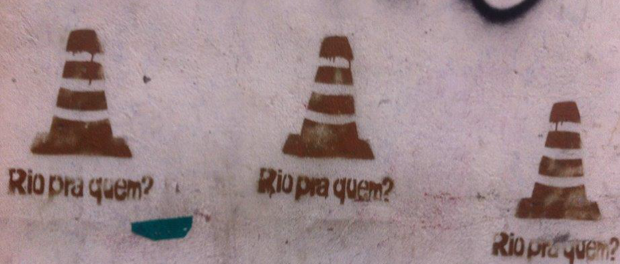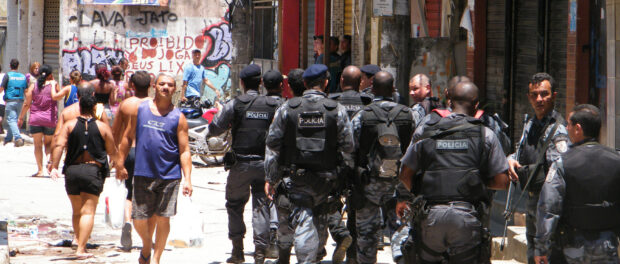
This is the transcript of a presentation given by Jessica Goodenough at the Future of Places conference in Stockholm in June and July, 2015. The conference gathered participants from all over the world, brought together by their passion for public spaces and placemaking, and their desire to influence Habitat III for a better urban future. This presentation condenses Jessica’s research on public spaces and public life in Rio de Janeiro’s favelas, which was conducted with Catalytic Communities in 2014 during her pursuit of a Master’s Degree in Sustainable Territorial Development.
‘Favela’ is the Brazilian name for the informal settlements that occur there. They are the birth place of many things we associate with Brazil: samba and football players, for example. My fieldwork focused on Providência, the oldest favela in Rio de Janeiro, on Rocinha, the densest informal settlement in the Americas, and Santa Marta, the most touristic favela in Rio (there’s even a statue of Michael Jackson). But I also experienced public life in other favelas during my time in Rio.
Favelas: Placemaking before it was cool
Favelas are never finished, constantly being built and rebuilt by their residents. And in the same way, the community that inhabits them traditionally managed and designed the public spaces there, often through the process of mutirão, which is a great word that means group work with benefits for all.
This form of urbanism, focused on people, and the density of favelas, means that favelas can be very conducive to walking, cycling and, when it exists, public transportation. Public spaces are relatively small there and respect the human scale. They’re not planned around the car or the separation of functions like some of our failed cities.
Public life and a sense of community
I feel that placemakers can learn a lot from favelas: there you can spot a street named after three friends who passed away, lovely little squares, a mirror in a bus shelter and a barbecue in an alley. You can feel the sense of community in the public spaces of the favelas: young children running around, many open doors and windows, people seeing into one another’s lives, and it’s generally quite loud.
Sadly, the public spaces in favelas also showcase the social problems that affect their communities. Brazil received by far the largest number of slaves during the Atlantic slave trade, and the consequences are still visible today through racial inequality and stigmas. The tensions I observed are also largely due to the two mega-events—the 2014 FIFA World Cup and the 2016 Olympic Games—which put the global spotlight on Rio de Janeiro.
Ostentatious urbanism
Towards the end of the 20th century, favelas went from being completely ignored by public authorities to having a few services provided, to being a place to showcase the arrival of the State. The modern, “clean” and cold aesthetic of state interventions contrasts with the informal, vernacular and warm nature of what existed before. But more importantly, public resources are wasted on symbols of top-down urbanization, like the cable car stations in some favelas.
Cable car projects look great on the official propaganda, but they cost millions while communities are asking for sanitation first (sewage currently spills through the streets down the hills). In Providência, the public authorities destroyed a much-loved square to build a cable car station that was not opened until 18 months after construction was completed. Even since the cable car was launched in July 2014, it has run only on a partial schedule.
Militarization of public space
In the same way, the “Pacifying” Police Units (UPPs) are made to be very visible in the cityscape, like a constant threat.
Police brutality and racial discrimination in the United States are all over the news. But between 2009 and 2013, the Brazilian police killed as many civilians as the police in the US killed in 30 years. Many of those deaths occurred in the favelas; some of them are like battlefields, even though the people actively involved in the drug trade represent less than 1% of favela residents.
Residents and human rights activists say that the Pacifying Police Units are for tourists and investors to see. I didn’t include the images of a ten-year-old killed by a stray bullet from police in April that went viral recently, but you get the idea: the police are very armed and present in the favelas. It’s a lose-lose situation: I have interviewed a few policemen and they are also scared for their lives, which makes them a bit jumpy with those big guns in their hands…
So, public spaces in the favelas went from being public de facto—as in, for the common use—to public de jure—as in, controlled by public authorities. Conflicts are linked to the undemocratic nature of this transition.
Context-sensitive “aesthetic of care”
But, you may ask, why should we care what happens in the favelas of Rio de Janeiro anyway? Well this conference is called the Future of Places and estimates predict that by 2050 one third of humanity will live in informal settlements, which will be approximately half of the world’s urban population. It is important to recognize and learn from the contribution of people who are less privileged, as they build our cities just as much as politicians, planners, architects and engineers do.
But, what should be done in Rio? Getting rid of the consolidation of elite power would be a good start, but other than that, it is important to be critical of mainstream media’s negative portrayal of favelas, as perception informs policy.
I hope that one day relationships can be built between trustworthy public authorities and residents, which will allow cooperative and context-sensitive projects rather than top-down monstrosities. There is a lot of potential for an aesthetic of care in Rio’s favelas, with projects that combine placemaking with green infrastructure, and are good for both people and the planet.
Hopefully, the international spotlight on Rio and its favelas in the lead-up to the Olympics will be a time of outcry against the human rights violations, but also an opportunity for a change in the narrative of urbanization in informal settlements, from top-down to bottom-up.
Jessica Goodenough conducted research on the qualities and challenges associated with the informality of public spaces in Rio’s favelas in the context of her ERASMUS MUNDUS International Masters in Sustainable Territorial Development.



